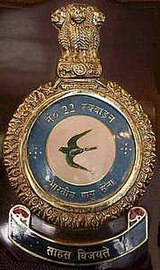1971 Operations
Air defence
On 22 November 1971, the squadron fought the first engagement that signified the opening of all out war in 1971, four Gnats operating from Dum Dum, engaged Sabres over Boyra salient, shot down two of them, and badly damaged one. The damaged aircraft however made it back to Tezgaon Airfield alongside the undamaged one. Two of the PAF pilots, namely Pervez Mehdi Qureshi, Khaleel Ahmed, ejected over the Boyra salient, and were taken POWs. [2]
Ground attack
No. 22 did not fly against ground targets until three days after the formal declaration of war. First of these was on 6 December, against Barisal Airfield, south of Dhaka. At 1200 hours, four Gnats flew against the airfield at Brisal, destroying all the hangars, and causing extensive damage to the bunkers around it.
The squadron also struck the Ishurdi airfield repeatedly between 5 and 8 December, and Jessore on 8 December. On 7 Dec, the squadron destroyed the Army Brigade at Khulna. [3]
Close air support
The most extensive ground support missions were flown against the Pakistani Army positions in Jessore. The Indian Army faced its most difficult task in the capture of Jessore, where the Pakistani Army had dug-in in concrete defences and defended every inch and were also aided by an effective artillery barrage. No 22 Sqn would strike these positions with Unguided bombs, destroying the defences in pinpoint attacks. Jessore would fall after this bloody confrontation. [3]
Bomber and transport escort
No. 22 provided crucial fighter escort to the Hunters and Canberras on strikes against positions deep inside East Pakistan. The Pakistani Air Force did not attempt to intercept these flights, and hence allowed these bombers to go through unhampered, causing extensive damage to railyards and strongholds. Gnats from No 22 would also provide fighter escort to the An-12s and Dakotas during the Tangail Airdrop on 11 December 1971. [3]
Anti shipping operations
The Pakistani ground forces attempted to retreat through small boats, motor launches and barges. The squadron carried out raids on Khulna, Banisol, and Godanad between 7 and 15 December, effectively stopping the escape. [3]
Post-War
In December 1975, the squadron moved to Hasimara, and in April 1978, it moved to Bagdogra and converted to HAL Ajeet Mk.1 aircraft in March 1982. On 20 December 1985, the unit was awarded the present crest of the Swift by the then President R. Venkataraman, and renamed to its current name. In February 1990, the squadron moved back to Hasimara, and converted to Mikoyan MiG-27ML aircraft. [4]
This page is based on this
Wikipedia article Text is available under the
CC BY-SA 4.0 license; additional terms may apply.
Images, videos and audio are available under their respective licenses.
